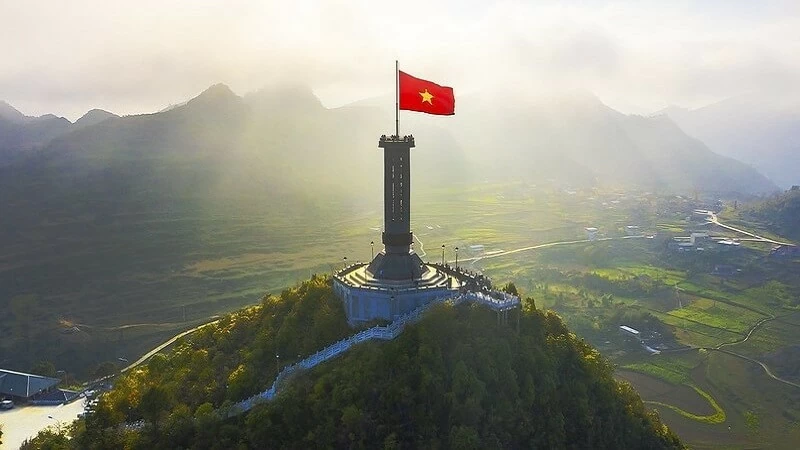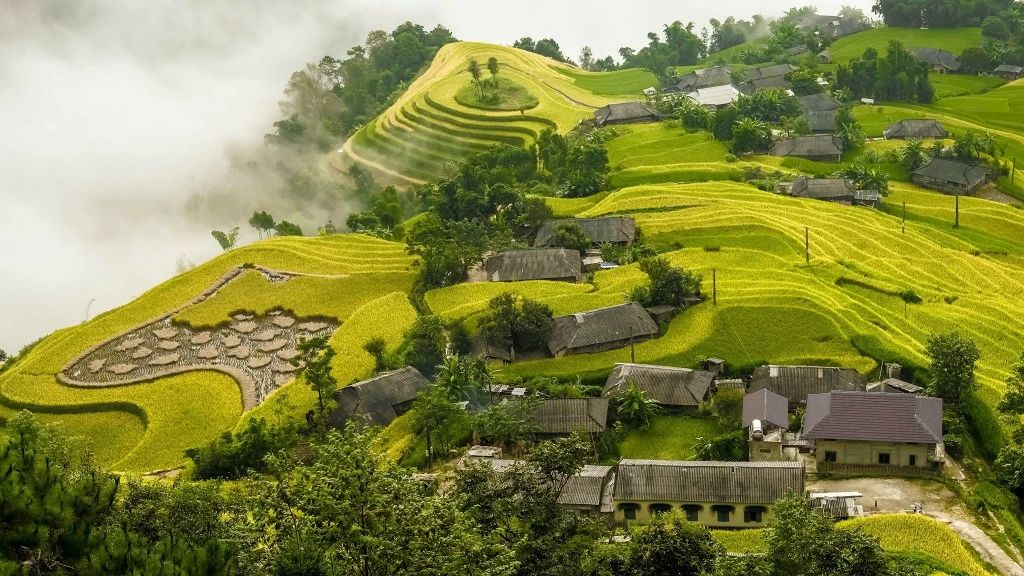
Wondering the splendid wilderness of Ha Giang
Latest
 |
| Located on top of Dragon Mountain, the Lung Cu flagpole in Ha Giang marks the northernmost point of the country. (Source: Ha Giang Portal) |
Ha Giang boasts significant potential in agriculture and forestry, with natural conditions favouring the development of crops, forestry, and livestock. Spanning an area of approximately 7,945 square kilometres, the province is home to over 850,000 residents.
Agriculture remains a cornerstone of Ha Giang's economy, with tea, temperate fruit trees, and medicinal plants being key products. Noteworthy items include Cam Sanh and Shan Tuyet tea, both recognized for their exceptional quality. The local government has been actively promoting the development of high-quality agricultural products and leveraging the province’s unique climate and terrain to enhance productivity.
Rich and diverse mineral resources also fuel the mining industry and deep mineral processing, driving Ha Giang’s development. Additionally, Ha Giang’s strategic location near the border with China positions it as a key player in cross-border trade and economic exchange, further boosting its economic potential.
A scenic wonderland
Ha Giang's landscape is nothing short of a natural masterpiece. Dong Van Old Quarter, established in the 20th century in Dong Van town, Ha Giang province, represents not only a living space for various ethnic groups but also a cultural and architectural gem deserving preservation in the region. Nestled among rocky mountains, this historic neighbourhood features about 40 houses, each over 100 years old, clustered closely together.
Visitors can admire the tranquil, ancient charm of grey walls illuminated by the golden morning sunlight. The evening transforms the quarter into a lively scene filled with the sounds of trumpets and traditional dances performed by local youth.
Especially vibrant from the 14th to the 16th of the third lunar month, Dong Van Old Quarter becomes adorned with red lanterns and hosts festivals showcasing unique activities, offering a deep dive into the rich cultural heritage of Ha Giang province.
The Ma Pi Leng Pass, often dubbed one of the "four great passes" of Vietnam, stands as Ha Giang's most famous tourist destination. Reaching the top of the pass reveals a full view of the vast Dong Van rocky plateau, the majestic Tu San canyon, and the Nho Que River gently flowing at the foot of the mountain.
Visitors can trek Tu San mountain, row on the Nho Que River, and camp overnight in this breathtaking area. Travelling during the ripe rice season or buckwheat flower season offers the chance to witness stunning terraced fields and flower valleys, adding an extra layer of beauty to the experience.
 |
| A corner of Dong Van market. (Source: Vietnam booking) |
Not to be missed are the terraced rice fields, particularly in Hoang Su Phi district. These ancient terraces, carved into the mountainsides by generations of farmers, turn into a sea of gold during the harvest season, creating a picturesque landscape that is a photographer's dream.
Cultural richness and ethnic diversity
Ha Giang is blessed with a long-standing culture dating back to the Dong Son Bronze Age, with prehistoric relics in Bac Me and Meo Vac. This province is home to 22 different ethnic groups, each with its own customs and cultures. Visiting Ha Giang provides an intimate glimpse into the lives of these communities, from their colourful traditional costumes to their unique festivals and rituals.
One of the best ways to experience the local culture is by visiting the markets, such as the Dong Van Market or the Meo Vac Market, which are held weekly. These markets are not only places of commerce but also social gatherings where locals exchange news, stories, and goods. The vibrant atmosphere, combined with the array of handmade crafts, textiles, and local produce, makes for an unforgettable cultural immersion.
 |
| Terraced fields in Phung village. (Source: Ha Giang Portal) |
Culinary delights
Ha Giang’s culinary landscape reflects its rich cultural diversity and abundant natural resources, offering a tantalizing array of unique and flavorful dishes. Smoked buffalo meat is a signature dish of the ethnic Thai and Tay communities. The meat is marinated with a blend of spices, including chilli, garlic, and ginger, before being hung over a wood fire to smoke and dry. This preservation method imparts a deep, smoky flavour to the meat, making it a delicious and long-lasting snack that pairs well with a glass of corn wine.
Thang Co, a traditional Hmong dish, captivates adventurous food lovers. Made from horse meat, bones, and offal, this hearty stew features a blend of spices like cardamom, cinnamon, and star anise. Cooked traditionally over an open flame, Thang Co delights at local markets and festivals, offering a true taste of Hmong culture.
Lastly, renowned for its unique flavour and health benefits, Au Tau porridge (bitter porridge) is a specialty of Ha Giang featuring the “au tau” root, a local medicinal plant. Slow-cooked with rice, minced pork, and various herbs, this porridge offers a rich and slightly bitter taste believed to have medicinal properties. Locals favour it, especially during cold winters.
Ha Giang is a place where nature's grandeur meets human ingenuity, where every corner holds a story waiting to be told. Whether seeking adventure, cultural enrichment, or simply a tranquil escape, Ha Giang promises a journey that will captivate the soul and inspire the spirit.













